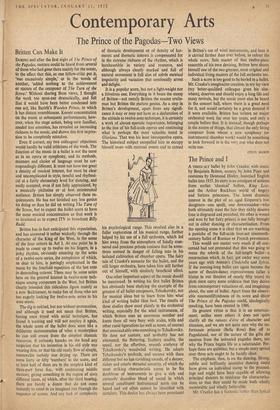The Prince and I A Thatee-acr ballet by John Cranko,
with music by Benjamin Britten, scenery by John Piper and costumes by Desmond Hecley, launched English ballet into 1957. Its story is an amalgam of notions from earlier 'classical' ballets, King Lear, and the Arthur Rackham world of bogeys and forlorn princesses. The latent dramatic interest in the plot of an aged Emperor's two daughters—one spoilt, one downtrodden—who both ultimately meet the fate they richly deserve (one is disgraced and punished, the other is wooed and won by her fairy prince) is not fully brought out in either dancing or characterisation. From the opening scene it is clear that we are watching a pastiche of the full-scale four-act nineteenth- century ballet of Russian or French provenance.
This would not matter very much if all con- cerned had note pretended that this was going to mean the rebirth of the full-length ballet—a resurrection which, in fact, got under way some years ago with Ashton's Cinderella and Sylvia. If the evening-long ballet can again become the norm of theatre-dance expressiveness (after a hiatus in our theatres of nearly fifty years) its plots must carry some evidence that they derive from contemporary valuations of, and imaginings about, the uses of ballet. Apart from the observ- able nineteenfiftyishness of its score and decor The Prince of the Pagodas could, ideologically speaking, have been created in 1906. Its greatest virtue is that it is an entertain- ment; unlike most others it does not -quite clarify all the raisons d'etre of character and situation, and we are not quite sure why the un- fortunate princess (Belle Rose) flies off to Pagodaland, nor of the nature of the gifts she receives from the animated pagodas there, nor why the Prince begins life as a salamander. Per- haps these are quibbles; but a simple story spread over three acts ought to be lucidly clear.
The emphasis, then, is on the dancing. Strong. subtle and brilliantly inventive dancing could have given an individual stamp to the proceed- ings and might have been capable of allowing principal dancers to reinforce the characterisa- tions so that they could he made both wholly memorable and wholly believable.
Mr. Cranko has a fantastic rather than lyrical imagination, and here the richness of fantasy in the many ensemble, spectacular and purely decorative dances is given full play—to the detriment of the story.
Act 1, the Emperor's Court, shows the wooing of the favoured princess, the dejection of the neglected daughter, and the appearance of the vision of the Pagoda Prince whose aides carry off the half-reluctant Belle Rose on her journey —flying `away on wires like the fairies in a good, old-fashioned panto. Act 2 consists of dances of elements and powers over which Belle Rose's aerial caravan floats from time to time. The Land of Pagodas finds her surrounded by a series of animated pagodas—box-like structures which sprout wings, feathers, fans, gyrating spires; they offer her gifts, they imprison her when she tries to move, and finally they part to reveal the salamander-like Prince who comes to woo her.
In the final act Prince and Princess return to the Emperor's kingdom, to find him deposed and encaged and his heiress-daughter enthroned—a situation of which the Prince (now an ex- salamander) makes short shrift : the evil are punished, all hearts are cheered, and Prince and Princess celebrate their loving betrothal in dancing.
The echoes before-mentioned, of Lear, The Sleeping Beauty, Rackhamite fairies and monsters, are not developed; they supply hints of some forthcoming political satire, some pene- trating comment on ethics and conduct, some fundamental psychological traits which would echo understandingly in our own hearts and minds. But these forewarnings disperse during the first act and the ballet reverts to the nineteenth- century formula of some mime interludes for the principals and a lot of decorative (or perhaps simply time-filling) display dances by the soloists and corps de ballet. These latter, especially in the first scene of Act 2, provide a surfeit of a richness which proves very cloying after the first five minutes; the best choreography is scattered all over the ballet, in short phrases or 'paragraphs' for an odd soloist here and there, rising to its richest expression in the celebratory pas de six and the two principals' pas de deux in the finale: The costumes range from sumptuous to sensible, including the coy and the plain ghastly; the decor, a not very inspired blending of poster- art, chinoiserie and lunar-landscape, is loaded with gimmicks—the agitated pagodas, fluttering drapes, the wire-flying, the non-stop trickery of
the lighting. Svetlana Beriosova as the central figure was cast to exploit all her poignant lyricism, but her still-developing dramatic flair (some day to create a violent shock to our ballet system) was given nothing to work upon. David Blair made a sauve and sympathetic, if at mo- ments uneasy, Salamander-Prince; dozens of other
A. V. COTON



































 Previous page
Previous page